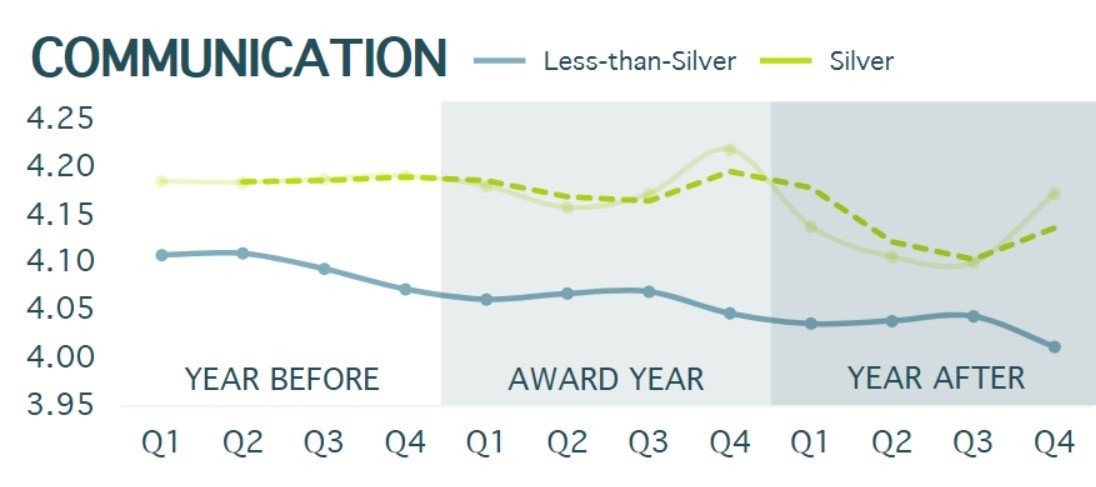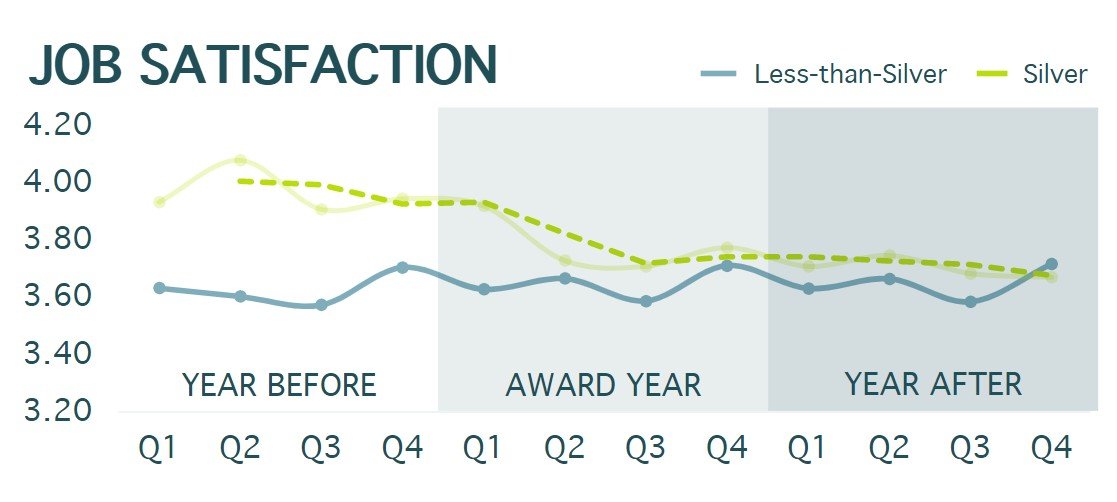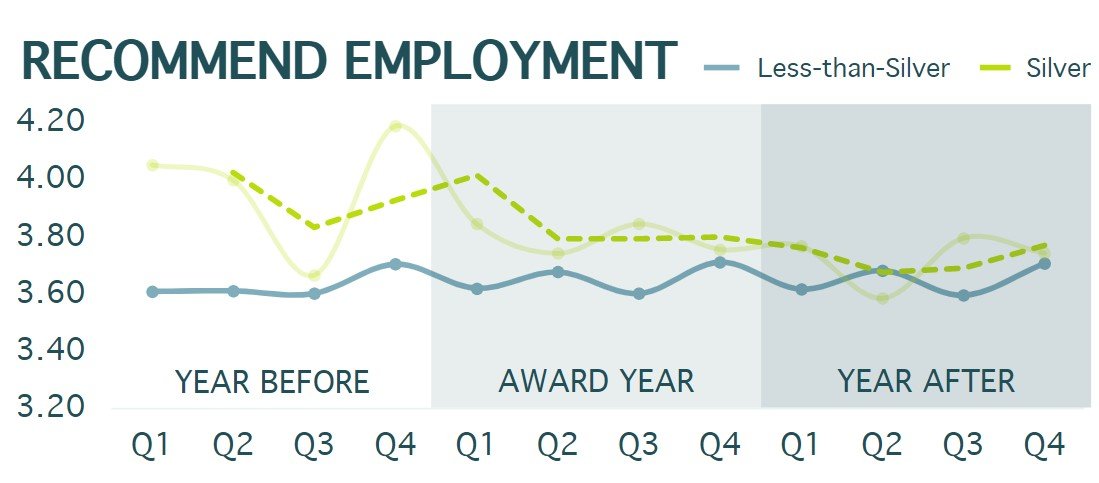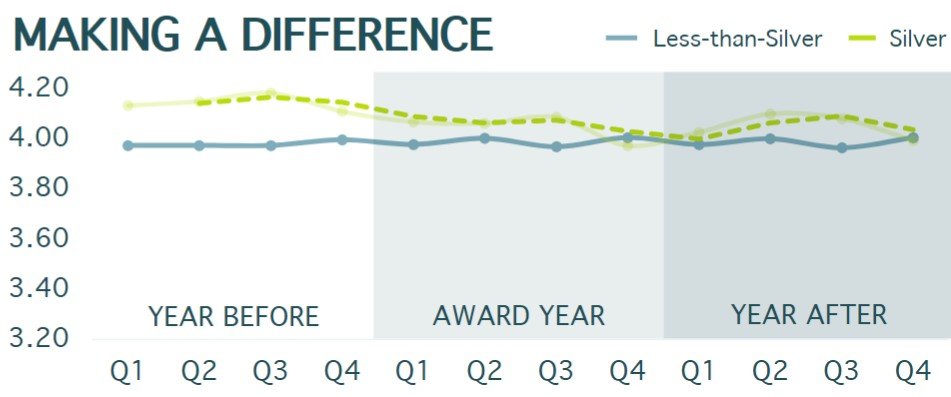AHCA Awards Correlate with Higher Employee, Customer Satisfaction, Study Finds
The American Health Care Association/National Center for Assisted Living (AHCA/NCAL) wanted to determine whether there is a correlation between their National Quality Awards and satisfaction among senior care staff and residents. To obtain the answer, they reached out to Pinnacle Quality Insight to compare data between the facilities that won National Quality Awards and those that did not.
Based on the data collected, it appears that AHCA’s National Quality Awards do correlate with higher employee and customer satisfaction scores the year before winning and in the year of the award.
Investigating the correlation between each study period and their corresponding performance scores, Pinnacle’s CEO Chris Magleby hypothesized the following:
The year prior to an award, winning facilities score highest for employee and customer satisfaction due to a greater sense of purpose and fulfillment among staff and its trickle-down effect on customers.
In the award year, award-winning facilities enjoy an advantage over non-winners due to the publication, recognition, and celebration of winning, and their resulting positive influences on employees and customers.
Read on to explore the comparison data between the study groups and key takeaways on the correlation between the study periods, facility performance, and AHCA’s National Quality Awards.
Methodology:
The study compared performance of silver National Quality Award winners versus facilities that did not win an award from 2018-2022 (with a focus on the year before, the year of, and the year after winning an award). Key Pinnacle survey questions for customer satisfaction and employee retention were used as scoring criteria for both groups. Silver National Quality Award winners were used for the study to ensure adequate sample size and statistical relevance. All study participants were Pinnacle customers.
Reviewing Satisfaction Scores the Year Before an AHCA National Quality Award
Employee Satisfaction the Year Before an AHCA National Quality Award
Facilities that won silver National Quality Awards for employee satisfaction enjoyed the greatest margin of superiority over non-winners the year prior to receiving the award. Awardees scored higher in each of the three most influential survey categories, with a 7.9% average higher score.
Customer Satisfaction the Year Before an AHCA National Quality Award
Like employee satisfaction winners, facilities that won awards for customer satisfaction scored an advantage over non-winners in every survey response category the year prior to receiving an award.
Satisfaction Scores in the Year of an AHCA National Quality Award
Employee Satisfaction the Year of an AHCA National Quality Award
Employee satisfaction scores remained higher on average for awardees in the award year but dropped from a 7.9% average higher score to 3.5%.
Customer Satisfaction in the Year of an AHCA National Quality Award
While employee satisfaction awardees saw their average higher scores reduced by about 4%, customer satisfaction scores at award-winning facilities climbed to their highest average margin of difference in the award year. Awardees scored 2.4% higher on average and experienced a noticeable spike in Q4 when the award was received.
Satisfaction Scores in the Year Following an AHCA National Quality Award
Employee Satisfaction the Year After an AHCA National Quality Award
Once again, silver NQA recipients scored higher on average in employee satisfaction than facilities that didn’t win an award. However, the gap between the two groups shrunk from 7.9% the year before to 3.5% in the award year to 1.8% the year after. Notable during this study period are the job satisfaction scores among non-winners surpassing awardees near the beginning of Q4.
Customer Satisfaction the Year After an AHCA National Quality Award
Customer satisfaction scores follow a similar downward trajectory at award-winning facilities, dropping from an average higher score of 2.4% in the award year to 1.8% in the year following an award.
Interpreting the Data in the Year Before an AHCA Award: The Roles of Process and Purpose
In reviewing the study results, Pinnacle CEO Chris Magleby speculated that the importance of preparing to qualify for the award could be at the root of the high scores during this period.
“I think what you’re looking at in the year before winning is the significance of process,” explained Magleby. “In the year before, facilities are putting processes into place to qualify for AHCA awards.”
“Thinking about it superficially, you’d imagine people wouldn’t like putting in the extra work to install processes and make the necessary improvements to qualify for the award,” Magleby continued. “But the data indicates that they actually prefer it.”
A study conducted by Adam Grant, an organizational psychology doctoral student at the University of Michigan, supports Magleby’s belief. Grant studied employees across a variety of industries to find ways in which job satisfaction and workplace productivity could be simultaneously improved. He found that both were boosted when individuals felt their work was having a positive impact on others.
According to an article in Psychology Today discussing Grant’s study, “Of 60 fire fighters studied, 10 actually hoped they could fight more fires so they could have a greater impact on people. Among telemarketers, those who believed their work had a positive impact on others were more satisfied with their jobs and actually had more sales per hour.”
When applying Grant’s research to the senior care industry where employees have a direct (and very important) impact on the lives of others, it stands to reason that going the extra mile outweighs the additional work required to do so—and leads to a greater sense of purpose and fulfillment. This is supported by high employee satisfaction scores across the board; the highest of which focused on making a difference.
As AHCA/NCAL noted in its review of the study, “the pursuit of the award is, in many ways, a more impactful process than achieving the award itself.”
“It stands to reason that going the extra mile outweighs the additional work required to do so—and leads to a greater sense of purpose and fulfillment.”
When employees are happier and putting in extra work, patients and residents reap the benefits. This translates to happier customers, improved perception of care, and the strong satisfaction scores seen in the year before an AHCA award.
Interpreting the Data in the Year of an AHCA Award: The Importance of Success, Celebration, and Ceremony
If process and purpose drive satisfaction ratings in the year spent working towards an award, the recognition and celebration of accomplishing that goal appear to contribute to ongoing positive feelings among employees and customers in the award year.
“People from these winning facilities are going to the AHCA Expo, getting a physical award, and bringing it back to the facility. The whole team is celebrating and showing this award in their meetings. This leads to galvanization, and you see the data reflect it,” says Magleby. “It shows the importance of ceremony. The importance of ritual and celebrating”
“The whole team is celebrating and showing this award in their meetings. This leads to galvanization, and you see the data reflect it.”
Findings from a Workhuman survey on rewards and recognition revealed that 86% of employees say they feel happier and prouder at work as a result of being recognized, while 85% say recognition made them feel more satisfied with their jobs.
The combination of achieving a goal and recognizing the individuals who made it possible provides the recognition that the Workhuman survey points to as a driver for employee satisfaction. A 3.5% higher satisfaction score among employees in the award year aligns with Magleby’s assertion and the Workhuman survey findings.
The timing of the award also coincides with the spike in customer satisfaction scores. When these awards are celebrated within the facility, they not only provide a boost to employees, but also advertise to the residents or patients that the quality of service is among the best in the country. This can have an extremely positive influence on customer perception. It’s why businesses ranging from auto manufacturers to restaurants promote awards. In addition to winning over new customers, it reassures existing customers that they’ve made a good choice, thus strengthening trust and loyalty. This all contributes to higher satisfaction scores, as supported by the data.
“When these awards are celebrated within the facility, they not only provide a boost to employees, but also advertise to the residents or patients that the quality of service is among the best in the country.”
Interpreting the Data in the Year After an AHCA Quality Award: Committing to Excellence
While scores remain higher on average, a downward trend occurred from the year of the award to the year after for both employee and customer satisfaction awardees.
“Part of me wonders if they’re losing the commitment to the processes they had to establish to qualify for the award in the first place,” Magleby posits. “It indicates to me that you should be trying to qualify for these awards every year because it has a huge impact on your staff satisfaction levels.”
The impact Magleby mentions isn’t limited to staff satisfaction. Customer satisfaction follows a similar trajectory from the award year to the year after, falling in each scoring category.
The Shelf Life of AHCA Award Influence and How to Extend It
The Pinnacle study data indicates that AHCA’s National Quality Awards do correlate with higher employee and customer satisfaction scores. However, it also shows the advantage isn’t everlasting. Facilities need to take measures to continue the processes and practices that earned them the high-performance scores in the year leading up to the award, and in the award year.
With workforce shortages and high turnover, retaining a commitment to excellence is an understandable challenge. Magleby suggests revisiting the workplace mindset and balancing the type of work being prioritized as a potential solution.
“Whenever I get the chance, I’ll talk to this industry about Stephen Covey’s four quadrants of time management. He splits up work tasks into things that are important and urgent, important and not urgent, urgent and not important, and neither important nor urgent.”
Covey, S. R. (1989). The Seven Habits of Highly Effective People. New York: Simon & Schuster
“In my experience, this sector seems to spend a lot of time on things that are urgent—both important and not. This is not unique to them. People in all industries do it. But you have to spend time doing things that are important and not urgent. Applying for these awards and going through this process is a non-urgent thing to do. But it shows you the importance of doing these non-urgent things.”
In other words, the gains made while applying for and winning a National Quality Award can easily be lost without careful tending. When award-winning facilities maintain the same level of dedication to excellence year over year, they are much more likely to not only win another award, but also to hold onto their enhanced employee and customer satisfaction.
Explore more strategies for improving employee satisfaction and retention in this free ebook.












